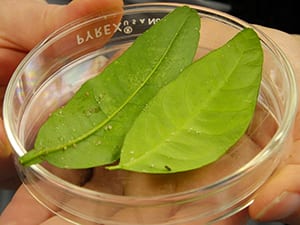News
New Cases of Citrus Greening Disease Emphasize Dire Need for Solutions

John Ramsey, postdoctoral associate in Cilia Lab, supported by the California Citrus Research Board and USDA Agricultural Research Service (ARS) headquarters.
The detection of 10 new citrus greening disease cases in California citrus trees weighed heavily on attendees of a recent citrus greening research meeting, including John Ramsey of the Cilia laboratory.
Researchers, cooperative extension staff, citrus growers and grower representatives discussed the news at the California Asian Citrus Psyllid and Huanglongbing Research and Extension Summit, held at the University of California at Davis on Sept. 9 and 10. Attendees gave updates on the status of their research to find strategies to control citrus greening disease, which has devastated the Florida citrus industry and continues to threaten California’s citrus growers.
The disease, also called huanglongbing, is caused by the bacterium Candidatus Liberibacter asiaticus (CLas) and spread by a tiny insect called the Asian citrus psyllid. Currently there is no effective treatment and infected trees produce unmarketable green fruits. Until recently, California had only had one infected tree, but the psyllid is already widespread in the state.
“There was a sense of inevitability,” said Ramsey. “It certainly does make it clear that there is a sense of urgency and people are really desperate for an effective solution.” Ramsey is a USDA Agricultural Research Service (ARS) Headquarters-funded postdoctoral associate and has also been supported by the California Citrus Research Board.
The California Department of Food and Agriculture detected the new cases of CLas in San Gabriel, Calif., a city in Los Angeles County earlier this year. The previous infected tree was located about 15 miles away, in a backyard in Hacienda Heights in 2012. They believe the two incidents are unrelated.
“A real crux of controlling the spread of disease in California is to educate homeowners who may have infected trees in their backyard, which can act as a reservoir of inoculum and are a terrific way for the disease to spread,” said Ramsey. “Homeowners are less likely to be using pest control than a commercial grove and that can exacerbate the problem.”
At the conference, Ramsey presented a talk about Cilia lab research using whole-proteome analyses, which take into account all proteins within the plant, to develop methods for early detection of the disease. Affected trees can appear to be healthy and productive long after the initial infection and so earlier detection is critical to slowing the bacterium’s spread. Ramsey’s work will be published soon in PLOS ONE.
Other researchers presented data at the conference that suggest that truck transport of citrus products has facilitated the movement of psyllids throughout California. The CDFA has already implemented quarantines to prevent the transport of citrus trees and fruits between citrus-growing areas in the state.
Additional strategies presented at the meeting include interbreeding commercial citrus varieties with wild relatives that have natural resistance to the disease and the using mass-produced predatory wasps that lay eggs in the psyllid nymphs to control them in groves.
“A big focus is how critical it is for the research to be communicated to the growers and to develop solutions that can be practically deployed,” said Ramsey. “It’s exciting to have the opportunity to take part in something that can potentially help the citrus growers.”
Cilia, who is a BTI Assistant Professor and USDA Agricultural Research Service Research Molecular Biologist, has recently traveled to California to present her results to the Citrus Research Board, a grower-led program that supports citrus research and has funded Cilia’s plant and insect-rearing facilities.
Additional Cilia lab members whose work contributed to the presentation include research technicians Faith Robison and Jaclyn Mahoney, a Cornell College of Agriculture and Life Sciences graduate, and College of Arts and Sciences chemistry major Jared Mohr. Earlier this year, Mohr was recognized with the Frank L. Howard Undergraduate Research Award for his work on using machine learning to develop early infection biomarkers by the American Phytopathological Society. Cornell plant pathology graduate student Annie Kruse and postdoctoral researcher Amit Levy also study citrus greening disease in the Cilia lab.


